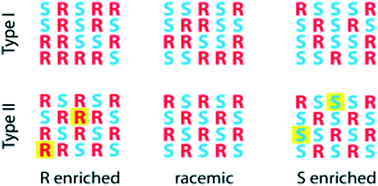On the structural aspects of solid solutions of enantiomers: an intriguing case study of enantiomer recognition in the solid state†
Abstract
Structural aspects of solid solutions of enantiomers have been considered and the corresponding definitions of type 1 and type 2 solid solutions have been revised based on the available structures reported in the literature. Examples of both types are presented indicating that (e.g., type 1 solid solutions) there is a straightforward relationship between the particular structural aspects and the enantiomer miscibility limits in the solid state. Furthermore, enantiomer recognition in a type 2 solid solution formed by the enantiomers of a pharmaceutically active ingredient, pimobendan, has been studied in more detail. It was found that upon rapid crystallization from a solution a structure possessing a fully disordered enantiomer layout forms. By suspending such a crystalline phase in a solvent over time it tends to form an ordered (racemic compound) state. The study demonstrates that a non-equilibrium crystalline phase reaches the equilibrium state structure, very similar to that determined by an SCXRD study of a slowly grown single crystal. The study also proves that the degree of enantiomer recognition in type 2 solid solutions has a profound thermodynamic origin, unlike that indirectly claimed in some literature sources to be arising from kinetic aspects during the crystal growth.



 Please wait while we load your content...
Please wait while we load your content...